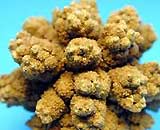The symptoms of bladder stones can easily be confused with benign prostatic hyperplasia or bladder tumors. If not detected and treated promptly, bladder stones can lead to complications such as ascending kidney infections and kidney failure…
 |
| Bladder Stones (Photo: SK&ĐS) |
Bladder stones are a common ailment in adults, accounting for about one-third of cases involving stones in the urinary system. The condition can affect both men and women, but is more prevalent in men.
In cases of small stones that do not cause bladder inflammation or urinary obstruction, there are often no significant symptoms. Many individuals discover their condition incidentally during abdominal or pelvic X-rays for other health issues.
Larger stones can cause irritation, compression, and obstruction at the junction of the bladder and urethra, leading to sharp pain in the lower abdomen that may radiate to the genital area or perineum, with increased pain towards the end of urination. Males may find themselves gripping the head of the penis to alleviate discomfort. Some individuals may also experience frequent urination, difficulty urinating, or intermittent urinary retention during a single urination session. In severe cases, complete urinary retention can occur, leading to urine accumulation in the bladder and causing a “bladder dome” above the pubic bone.
When infection occurs due to bladder stones, patients may experience sharp pain during urination, frequent urges to urinate, cloudy urine, and blood in the urine, particularly towards the end of urination. If not diagnosed and treated early, this can lead to complications such as acute or chronic cystitis, bladder atrophy, and bladder fistulas, which can cause urine to leak into the perineum or vagina, resulting in continuous leakage and potential infection over time. Additionally, two other serious complications include kidney infections due to backflow and kidney failure. These complications are costly to treat and pose significant health risks.
The symptoms of bladder stones share many clinical features that can be confused with conditions such as benign prostatic hyperplasia or bladder tumors. Therefore, to accurately diagnose the condition and prevent complications, it is essential to seek a consultation in urology immediately upon noticing the aforementioned symptoms.
Bladder stones are caused by multiple factors, which may include stones originating from the kidneys and ureters, small stones that can be expelled through urine, or larger stones that get stuck and gradually grow larger due to the accumulation of additional deposits. They can also form as a result of medications used to treat other conditions that precipitate and deposit substances leading to stone formation. In some cases, bladder stones may result from conditions that cause narrowing of the bladder neck, such as benign prostatic hyperplasia, urethral strictures, bladder diverticula, or foreign bodies within the bladder, which can accumulate deposits over time.
To prevent the condition, it is important to drink at least 1.5 liters of water daily. Individuals undergoing medical treatment should pay particular attention to hydration to avoid stone accumulation (including both kidney and bladder stones). When experiencing stones and bladder infections, patients should maintain good hygiene for the urinary tract and use antibiotics as prescribed by their healthcare provider. Depending on the severity of the stones, doctors may recommend surgery or endoscopic procedures. Currently, provincial and central hospitals can effectively manage bladder stones. Early detection of the condition is crucial for successful treatment and to avoid unfortunate complications.
Dr. Nguyễn Trung Dũng


















































